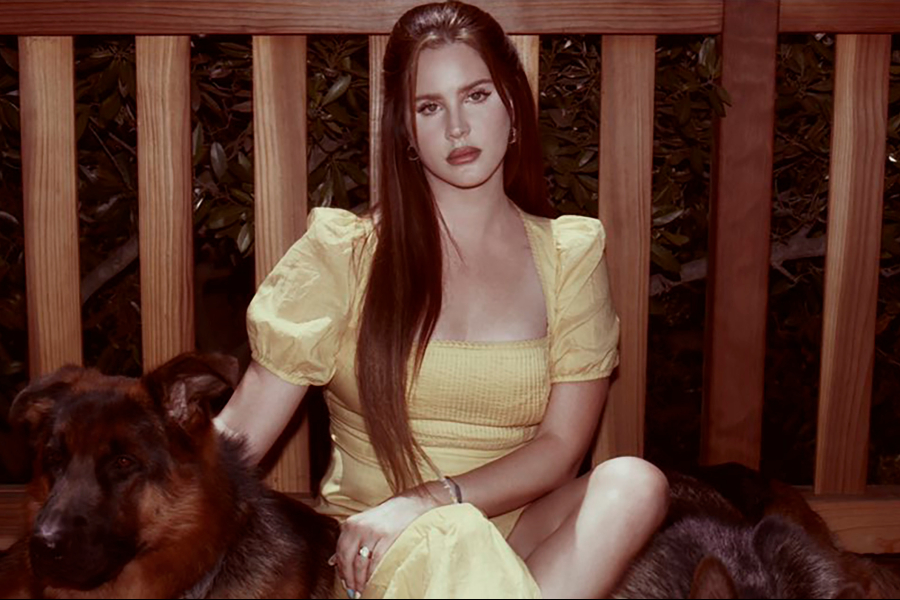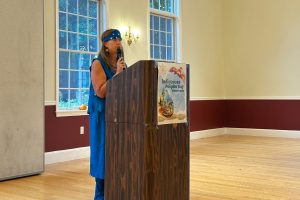‘Blue Banisters’ is beyond “something beautiful”
Courtesy of Lana Del Rey (Twitter) and NME.com
Blue Banisters marks Del Rey’s second studio album in seven months.
October 29, 2021
With the punctual drop of a seventh studio album, Blue Banisters on Friday, Oct. 22, singer-songwriter Lana Del Rey has certainly proved her prowess as a “Living Legend”.
Released seven months after her previous album, Chemtrails over the Country Club, Blue Banisters is the behind-the-scenes collaboration of several producers and songwriters, including Del Rey’s sister and father, Chuck and Rob Grant.
Del Rey started her musical journey when she began to explore the visual medium of film paired with classical music. Although she has a number of influences, she has strived to take the road less traveled since the start of her music career.
“I had a vision of making my life a work of art,” Del Rey said in a 2012 interview with Myspace.
And Blue Banisters proves that she hasn’t lost sight of that goal. Poetic verse litters the album in the form of flower motifs and religious imagery as Del Rey delves into the deeply personal aspects of her romantic and familial relationships.
“Blue Banisters”, the titular track, perfectly encapsulates the feelings of the singer-songwriter towards the color blue. Appearing in many of her songs, blue is used to represent sadness, hope, melancholy, and everything in between. Even though there isn’t a lot of variation in the backing track, the subtle changing of Del Rey’s “banisters” from “blue” to “green and gray” represents the fading of a romantic relationship, as Del Rey’s sisters comfort her in the mellow aftermath.
Del Rey more directly establishes blue as a versatile color of emotion in “Beautiful”, the album’s seventh track. She tells her partner not to feign joy when there’s pain underneath, while still boldly claiming, “Let me show you how sadness can turn into happiness/I can turn blue into something beautiful”.
“Black Bathing Suit” is one of the more striking songs on the album. While previous songs start out gently, slowly enticing the listener to pay attention to Del Rey’s soft melodies, “Black Bathing Suit” starts out with the jarring sound of a crow caw. Referencing the length of the pandemic, Del Rey mentions how she badly craves a relationship: “Cause my body is my temple, my heart is one too/The only thing that still fits me is this black bathing suit”.
The reference to a “black bathing suit” reminds me of songs such as “Little Black Dress” by Sara Bareilles and “Tim McGraw” by Taylor Swift, which both mention the wearing of a “black dress”. All of these black clothing pieces are referenced to idealize the character in question, as what’s on the outside can never truly represent what’s inside.
Going along with the album’s theme of dissecting personal relationships, Del Rey proceeds to elucidate the disconnect between this appearance and her deep-rooted familial struggles, remarking, “I guess I’m complicated, my life’s sorta too/I wish you could see to my soul through this black bathing suit”.
The pre-album single “Arcadia” is a nod to Arcadia in L.A. County, Calif., a continued source of inspiration for del Rey. After moving to California in 2012, she considers herself to be a California girl, and has previously referenced the state in songs such as “Venice Beach”, “Malibu”, and, well, “California”. In a profession of love, del Rey describes her body as “a map of L.A.”, with all roads that lead there “as integral as arteries”.
Romantic partners then become likened to ethereal experiences in “Living Legend” and “Nectar of the Gods”. Rather than using rock instrumentation to illustrate strong feelings, Del Rey uses religious subtext to further the emotional connection while a peaceful guitar plays in the background. She talks about how the love she experiences “send[s] [her] straight to heaven” and the “heroin gold in [her] veins” which gets her hooked on the relationship. She then ties it back to her previous motifs of blue, singing that she gets “wild and […] crazy like the color blue” as another indicator of her intense relationship.
Ultimately, his album deserves an 8/10. On the surface, many of her songs maintain a similar composition of a piano ballad backed by gentle guitar strumming. However, each song paints a story, with a clear beginning, middle, and end. With each subtle lyric change as each song progresses, Del Rey builds up to a bridge that ties her broad-based metaphors to deeply personal revelations.
For anyone that likes this album and wants an introduction to Del Rey’s music, I recommend listening to “Summertime Sadness” and “Born to Die” from her 2012 album Born to Die and “Love” from her 2017 album Lust for Life.
To listen to other similar artists, check out “Solitaire” by MARINA and “Green Light” by Lorde.









Srinithi Raj • Oct 30, 2021 at 11:24 am
Lovely review, Kristen!